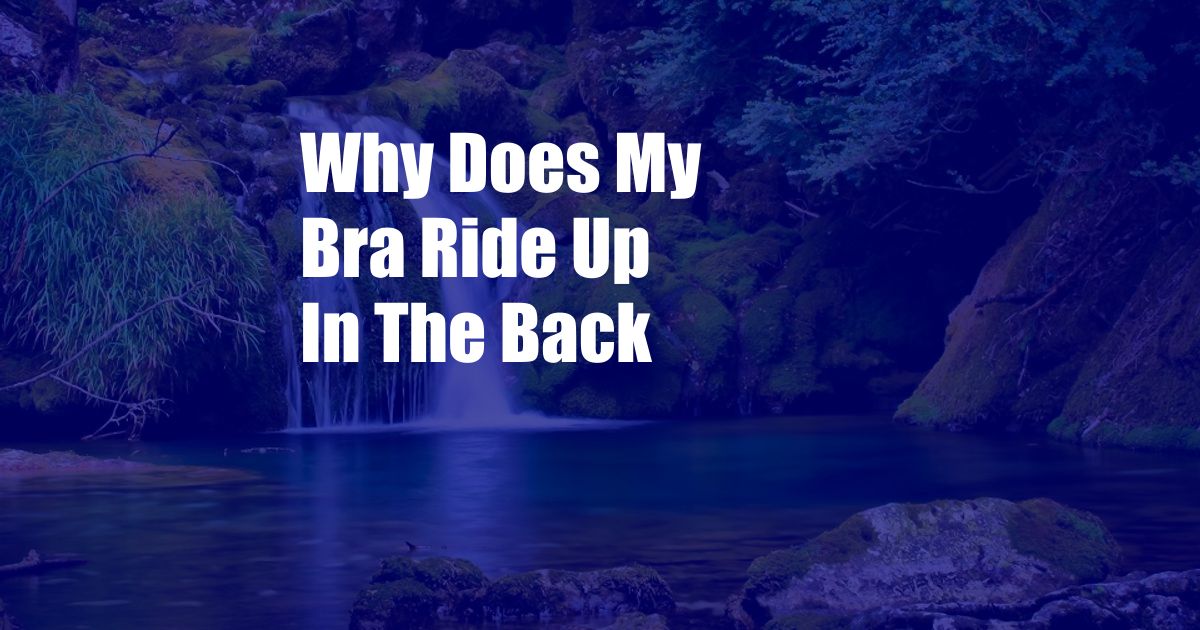
Why Does My Bra Ride Up in the Back?
Imagine this: you’re halfway through a presentation, feeling confident and in control. Suddenly, you feel an uncomfortable sensation against your back. You discreetly lift your shirt, embarrassed to discover that your bra has ridden up, exposing a bit of skin beneath. This is a common scenario that many women face, and it can be incredibly frustrating.
In this article, we’ll delve into the underlying reasons why your bra rides up in the back, exploring the physical and design factors that contribute to this issue. We’ll also provide expert advice and practical tips to help you find a solution that keeps your bra in place. So, ladies, get ready to say goodbye to the dreaded bra ride-up and embrace a secure and comfortable fit.
Understanding the Causes
Bra riding up in the back can be attributed to a combination of physical factors and bra design. Let’s take a closer look at each of these:
Physical Factors
- **Body shape:** Women with relatively shorter torsos and larger breasts may be more prone to bra riding up. This is because the bra band tends to sit higher on the back, increasing the likelihood of it riding up.
- **Back curvature:** The shape of the spine can also play a role. Those with a pronounced lower back curvature may find that their bra band fits too tightly, causing it to ride up.
- **Breast density:** Dense breast tissue can put extra pressure on the bra band, pushing it upwards.
Bra Design Factors
- **Incorrect band size:** The bra band should fit snugly around your rib cage, providing most of the support. If the band is too loose, it will move around, allowing the bra to ride up.
- **Too-wide shoulder straps:** Wide straps may not provide sufficient support, especially for larger breasts. This can cause the bra to slip off the shoulders, resulting in a ride-up.
- **Inappropriate bra style:** Some bra styles, such as plunge bras or balconette bras, are designed to sit lower on the bust. If you have a high bust or a longer torso, these styles may not offer the necessary support, leading to bra riding up.
Tips and Expert Advice
Now that we’ve identified the causes, let’s explore some expert advice and practical tips to address the issue of bra riding up in the back.
Get Fitted Properly
A professional bra fitting is crucial to ensure that your bra fits correctly and provides optimal support. A knowledgeable fitter will measure your band size, cup size, and torso length to find the perfect match for your unique body shape.
Adjust the Bra Band
The bra band should fit comfortably around your rib cage. If it’s too loose, tighten the straps; if it’s too tight, loosen the straps. Remember, the bra band should provide 80% of the support, while the straps should only provide 20%.
Choose the Right Bra Style
Depending on your body shape and breast size, certain bra styles may offer better support than others. For example, women with a larger bust may consider full-coverage bras with wide, adjustable straps. Those with a smaller bust may prefer demi-cup bras or balconette bras.
Use a Bra Extender
If you find that your bra band is too tight, you can use a bra extender. This small device adds extra length to the bra band, providing additional comfort and preventing the bra from riding up.
Frequently Asked Questions (FAQs)
Q: Why does my bra ride up when I bend over?
A: This is often due to an incorrect band size or wide shoulder straps. The band should fit snugly around your rib cage, providing most of the support, even when you’re bending over.
Q: What type of bra is best for preventing bra riding up?
A: Full-coverage bras with wide, adjustable straps offer the best support, making them less likely to ride up. Sports bras and wireless bras are also good options for comfort and support.
Q: How can I tell if my bra band is too loose or too tight?
A: If you can fit more than two fingers under the band while it’s hooked on the loosest setting, it’s too loose. If it’s difficult to fasten the bra on the loosest setting, it’s too tight.
Conclusion
The issue of bras riding up in the back can be frustrating, but it’s one that can be solved with a combination of understanding the causes and implementing practical solutions. By getting a proper bra fitting, adjusting the band, choosing the right style, and using a bra extender if necessary, you can achieve a secure and comfortable fit. Remember, a well-fitting bra is essential for both comfort and confidence. Don’t hesitate to seek professional advice or experiment with different bra styles to find the one that works best for your unique body shape.
Are you interested in learning more about bra fit and support? Leave a comment below and share your experiences or questions. Together, we can empower women to find the perfect bra that keeps them supported and comfortable throughout the day.